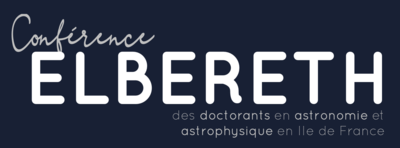Orateur
Description
The TRAPPIST-1 (T-1) planets are among the most promising candidates for the first detailed study of temperate terrestrial exoplanets with the James Webb Space Telescope (JWST). CEA is leading a guaranteed-time observation (GTO) program that is dedicated to the observation of 5 occultations of T-1b with the Mid-Infrared Instrument (MIRI) at 12.8 μm (ID: 1279), paired with a similar program at 15 μm (ID: 1177). The reason that motivates these GTOs lays in the fact that T-1b is believed to have a day-side thermal emission large enough to be detected through the observation of a few occultations with MIRI, which could bring key insights into the existence of an atmosphere. In the past, detection of T-1b’s occultations was attempted with Spitzer/IRAC, but inconclusive (Ducrot el al. 2020). In this talk, we (1) introduce our pipeline specially designed to analyse photometric time series data, (2) show its feasibility on existing Spitzer observations of bright sources, and (3) move on fainter sources to show its outcomes on realistic simulations of T-1b with JWST/MIRI for different planet properties. To detect low significance signals such as occultations (expected ≃ 150 ppm for T-1b) our pipeline is based on a Blind source separation (BSS) method. First, we analyse the phase-curves of two hot Jupiters, WASP-12b and WASP-18b, obtained from 190 hours of observations with Spitzer at 3.6 and 4.5 μm. This consists of applying aperture photometry, followed by a wavelet transform to get time and frequency observations scales, and then an Independent Component Analysis (ICA) in the wavelet domain to get rid of the high-frequency scatter (Waldmann et al., 2014, Morello et al., 2015). ICA maximizes the different components non-gaussianity (Stone et al., 2004) (ie. minimizes the negentropy) which is convenient for Spitzer/IRAC as highly non-gaussian systematics is optimal for component separation. Hence we derive an updated upper-constraint on the brightness temperature of the planets. Then, to prepare for GTOs 1279&1177 observations, we test our pipeline on 5 simulated occultations of T-1b at 12.8 and 15 μm. These are made by creating realistic time series observations (Martin-Lagarde et al., 2020), adding detector noises, non-linearities (Klaassen et al., 2021) and temporal drifts (Martin-Lagarde et al.,2020). Data reduction is done using the STScI pipeline. Finally, we compare the outcomes from our BSS approach to a more standard method using parametric noise models. We show that we detect the occultation of T-1b at least at 3σ in both wavelengths for a day-side temperature of 400 K.
Day constaints
Can I make the presentation on Wednesday? I teach on Thursdays and Fridays therefore I can not attend the conference on those days.
| Field | Planetology (including small bodies and exoplanets) |
|---|

